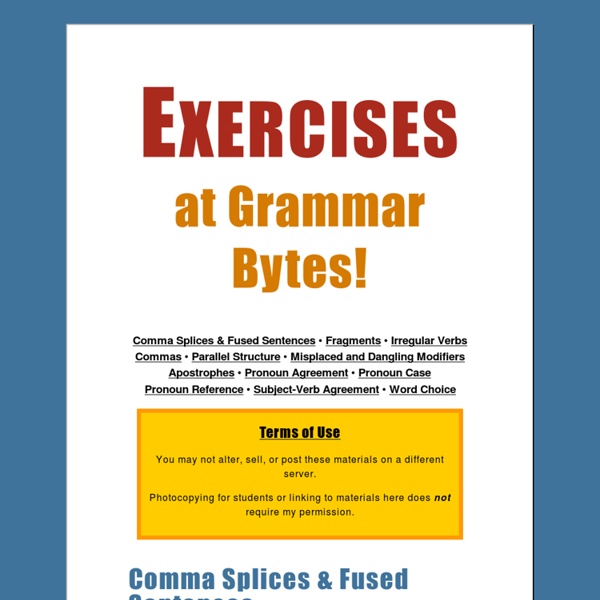How to Write a Five-Paragraph Essay
By Grace Fleming Updated October 27, 2015. As you've probably noticed, essay writing assignments can pop up in any class. An essay is a literary composition that expresses a certain idea, claim, or concept and backs it up with supporting statements. It will follow a logical pattern, to include an introductory paragraph (make the claim), a body (support), and a conclusion (summary of statements and support). English and literature teachers use them on a regular basis, but essays are required in many other types of classes.
Simple Past
[VERB+ed] or irregular verbs Examples: You called Debbie. Did you call Debbie? You did not call Debbie. Complete List of Simple Past Forms
Welcome to Great Source iwrite!
State-of-the-Art Science Program Grades K–8 Science Program Combining interactive write-in texts, hands-on activities, and a full digital curriculum, ScienceFusion provides multimodal learning options to build inquiry and STEM skills, preparing students for success in future science courses and careers.
How to teach writing: writing lesson ideas
Does any of this sound familiar? Yes, but writing is boring. Is it? Sure, but writing could be time spent in class doing fun speaking tasks. Who said you can’t do both? But my students get more out of class from interactive activities.
Fun English Learning Games
Show me more Fun English learning games is a unique and proven English language course for kids. ★ A free to try version of Fun English Learning Games. ★ Colors lesson is free and includes 6 English learning games. ★ Chosen by more than 2,000,000 parents and kids worldwide. ★ Teaches children English language through games and activities. ★ Designed by language learning experts for kids aged from 3-10. ★ Suitable for toddlers, preschool children and kindergarten kids. ★ Older kids and adults enjoy Fun English too! Fun English combines a structured English language course with engaging and entertaining games. Our language learning activities keep your child entertained and occupied whilst introducing them to English words, sentences, speaking and spelling.
English Grammar and Writing : English language courses, English Grammar Online
Do you have a question about the correct usage of the semi-colon or how to place relative adverbs in a sentence? If so, you've come to the right place! The edufind.com English grammar guide is a complete reference on the rules of English usage.
The Big List of Class Discussion Strategies
Listen to this article as a podcast episode: Podcast: Play in new window | Download (Duration: 38:22 — 53.1MB) Subscribe: iTunes | Android | When I worked with student teachers on developing effective lesson plans, one thing I always asked them to revise was the phrase “We will discuss.” We will discuss the video. We will discuss the story.
English Grammar Book
Show me more This application is the best way to improve your English Grammar at home, on the move, anywhere! Grab it and Master it. What is included in the app?
On Twitter, is it 'he or she' or 'they' or 'ip'?
(CNN) -- Twitter users may value brevity in their messages, but that doesn't mean they don't think about the social implications of language. Is this sign sexist? Some say our language should be more inclusive of both genders. "Can't we English-speakers just agree upon a gender-neutral pronoun?" attorney Paul Easton recently Twittered. "Tired of PC grammar gymnastics."
Teaching Grammar through listening (English-as-a-foreign-language version)
1. Introduction In all of my posts on grammar instruction I have made the very important point that for grammar to be fully acquired it must be practised extensively through all four skills. However, this is not what usually happens, grammar practice occurring in most language classrooms predominantly through the written medium. Hence grammar is mostly read and written, but rarely processed aurally and orally. Of the four language skills, the one that is always neglected in grammar instruction is definitely Listening.
CyberGrammar Homepage
sentence structure
Simple sentences: A simple sentence has only one clause: The children were laughing. John wanted a new bicycle. All the girls are learning English. Compound sentences:
Language Learning Experts' Favourite Strategies in 2016
Language experts reveal their top language learning strategies in 2016 I can’t believe there are only a couple of days left of 2016! It’s been an interesting year in many different ways and I’m sure you guys have made a lot of progress in at least one area of your language learning. What’s a better way to celebrate the transition to 2017 than to gather advice from some of the most interesting language learners and bloggers out there. I’ve asked 17 people what their number one language learning strategy was in 2016 and here are their answers!
ESL Reading Exercises, Printable worksheets & Text Mazes
Movie worksheets- Teach English using English movies, Printable worksheets for movies-Have fun!! Music activities- Teach English using English songs- Worksheets to teach with English songs- It really works!! Word Formation Worksheets- Teaching prefixes & Suffixes (affixes) to high level students can greatly help to speed up vocabulary building-Try these worksheets in your lessons. Quizzes & Cloze Exercise: Printable quizzes, cloze & gap fill exercises. Adult Communicative Lesson plans: Help adults practice grammar & vocabulary using communicative exercises




I am glad you find it helpful and interesting! by vlado Oct 25
These interactive and creative grammar exercises are a great resource for students who want to practice more their writing skills. Exercises like word choice, irregular verbs and fused sentences are included. Not only students can work interactively but they can also print out PDF handouts so they can keep track of what they are doing. by sindy11 Oct 7